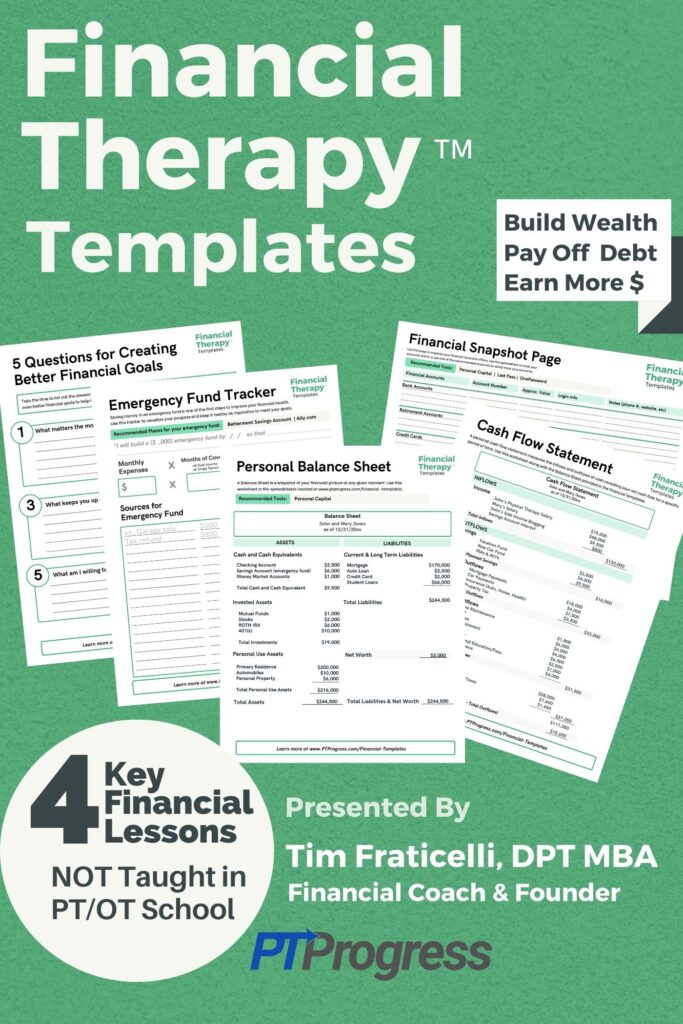
Have you made a goal this year to improve your finances? Did you resolve to “make more money” or “pay down debts”? Believe it or not, such vague, financial goals are unhelpful, and you’re unlikely to make any progress.
I’d like to share 5 questions you can use to create smarter, attainable goals.
Financial Goals…from a Physical Therapist?
As a Physical Therapist and Certified Financial Planner™ professional, I love talking about finances with PTs and PT students.
Besides helping patients reach physical milestones as they recover from their injuries, I enjoy helping PTs experience financial success. The strategy for both processes is surprisingly similar, and it begins by creating goals.
But we’re not looking for just any type of goal. When setting financial goals, there are mindsets to adopt and mindsets to avoid. Allow me to use an example from the clinic to illustrate the difference between a smart goal and a, well, not-so-smart goal.
SMART Goals Vs. Dumb Goals
As a physical therapist, you’d think it would come as second nature to develop amazing financial goals. After all, we create goals every day for our patients, helping them overcome pain and build strength so they can return to doing what they want.
So from your experience in the clinic, how would you rate the following physical therapy goals: “To help the patient get better,” or “To help the patient get stronger.”
These goals are pretty dumb. They are too broad and too vague to be useful to you or the patient. However, when you think about it, they’re not much better than financial goals such as “I want to get better with money” or “I want to get out of debt.”
Despite your good intentions in making such goals, you won’t have success in reaching them. I fall into this trap sometimes, too. In order for goals to be effective, they need to be a lot more specific than “I want to be financially independent,” or “I want to make more money.”
Now I’m going to assume that you know about the SMART goal formula, which stipulates that in order for a goal to be useful and effective, it needs to be Specific, Measurable, Attainable, Realistic and Time-bound. Since its original publication in 1981, it’s proven to be an easy framework many people can follow.
SMART Financial Goals Need A Big-Picture Context
As you set these SMART financial goals, put them in the context of the bigger picture of your life – the things that are important to you. Don’t simply aspire to “pay off student loans.”
While I’m not suggesting you ignore your student loans, I argue that such a limited goal isn’t good enough. Why? Because you are more than a dutiful student debtor. You have ambitions, hobbies, dreams, family, a career, and all the other aspects in your life that deserve to be considered when making financial goals. You need to have objectives that align with your goals, that guide and fuel them.
Looking at the big picture is hard, especially when it’s of our finances. To make the process a little easier for you, below are 5 questions that you can ask yourself to help identify financial goals that are specific and holistic.
5 Questions to Create Better Financial Goals
I’m not asking you to remove your PT hat here and become a financial planner. Instead, I encourage you to let the way you evaluate your patients in the clinic inspire the way you think about your financial goals.
Think about it: how does a PT evaluation begin? Usually by sitting down with the patient and casually talking about the things that matter most to them.
When conducting an evaluation, having a few focused questions can really help guide the conversation in the right direction. So here are some hand-picked questions you can use to evaluate your situation and set successful financial goals.
Question #1 What is most important to you in life?
Is it your family? Freedom to be independent in your work, travel, or living situation? Is your career or business really important to you? What about taking vacations every year or giving to charities?
Maybe it feels really “heady” to think about what’s most important to you, but it does make a difference.
Imagine if I were to create a huge list of goals for a patient of mine who had just had a total knee replacement, and I jotted down goals like hiking, running, or mowing the grass. All those things sound like decent goals, except that my patient isn’t interested in any of those activities. By not taking the time to ask him what’s most important in his life, I missed out on an opportunity to set goals he’ll really care about. The same principle applies to creating our financial goals.
Financial Goals Need A “Why” – Not Just A “How Much”
Objectively speaking, saving $10,000 in one year is a great accomplishment. But you’ll be more motivated to stay on task if that goal is tied to a valuable objective, such as creating an emergency fund for a new business you’ve always wanted to start. By grounding it in the bigger picture, your goal will be more important to you, and the efforts you make to save $10,000 over the next 12 months will more successfully fund the peace of mind you want for your business.
Big-picture goals are reached through incremental steps and doable deadlines. Let’s say one objective that’s really important to you is being able to travel with your family or partner every year, despite having a tight budget. To attain that big-picture objective, you set a goal to trim your expenses and automate your savings each month into an investment account like Betterment or Acorns.
So instead of setting a “dumb” goal of “Save more money,” you’ve set a smart goal of “Start an automatic savings transfer of $50/month to our vacation fund by July 31.” Now that’s a goal you can work towards.
Bottom line: Make goals that are important to you. Don’t just copy and paste some YouTuber’s list of “10 financial goals to hit before age 30” if those goals don’t align with the things that matter most to you.
Question #2: What gives you the greatest sense of fulfillment or joy?
Your answers to this question might overlap a little with those of the first question, and that’s ok. But for me, this question addresses things like my hobbies, side businesses, physical exercise, and spending time with my family in the evenings. Perhaps for you it includes working in your yard, playing golf with your kids, practicing guitar or teaching your kids chess. It doesn’t have to be grandiose or noble – it’s just whatever brings you joy and contentment.
Writing these things out will help you create relevant, meaningful financial goals – goals that will tangibly bring more joy and fulfillment to your life.
Financial Goals Need A Meaningful Application
The financial goal of “save $1,000,000 by age 50” is meaningless. But with a meaningful application, such as “…so I can reduce my work hours by 50% and spend more time taking vacations while my kids are in high school,” that same goal transforms into something that will bring attainable joy and fulfillment to your life.
Similarly, consider the following two goals for a physical therapist in professional development: “I will invest $150/year in continuing education,” or, “I will invest $150 to learn how to write better documentation faster so I can ultimately spend more time with my kids in the evenings.”
By adding a personal “why,” the second goal instantly transforms a generic, career-development goal into a conduit for things the PT finds fulfilling. (And if you’re a Physical Therapist who resonates with that goal, check out this course for Learning Efficient Documentation.)
Bottom line: When setting financial or career goals, take the time to consider what brings you the greatest sense of fulfillment or joy.
Question #3: What keeps you up at night?
Have you ever lain awake at night ruminating over worrisome scenarios you can’t get out of your head? Before you shove them out of your mind, evaluate: What are those things that make you worry? Is it your debt, your career path? Your family, kids, or your current living situation?
I know this is difficult to think through. But just like when we discuss obstacles with our patients in the clinic, we need to honestly write out our fears and anxieties regarding our career and finances.
Facing Fears Helps Make Financial Goals
Writing down big fears such as “Losing my job,” or “Not having enough money to put food on the table,” will work in your favor in a couple of ways:
1. It Breaks The Cycle of Worrying
Ever heard of rumination? That thing cows do? They eat some grass, chew it, digest it, then regurgitate and start the cycle all over again. Worrying, when left on its own, turns into rumination and fuels paralyzing anxiety. Ruminating is not productive for building financial goals. Instead, the next time your brain identifies the worst that can happen, stop the cycle and ask “ok, so then what would I do?”
Don’t just ruminate on your fear. Think it through. By taking the time to ponder, “Ok if the worst happened, what would I do?” you give yourself a chance to come up with a possible solution and break the cycle of worry.
Besides giving you peace from incessant worrying, there’s a second reason why writing down these worries will help you make financial goals.
2. It Channels Fear Into Motivation
Fear is a primal instinct that our brain uses to incite a fight or flight response when we feel threatened. Use those fears – fear of bankruptcy, unemployment, endless debt, etc. – to motivate you into action. Although you shouldn’t dwell on your worries, considering them can help you prepare a more productive response and create a plan of attack.
When it comes to your career and financial worries, having a financial plan – built with goals you care about – will help you face your fears with confidence. Build that confidence now by addressing the hard questions before uncertainty rears its ugly head. When hard times come, you’ll be able to consult your plan and choose how to respond.
This mentality especially applies when it comes to investing. The stock market can cause a lot of uncertainty. But if you identify your anxieties and contemplate a plan for your financial goals, you’ll make exponentially better investment decisions.
Bottom line: Don’t ignore the things that keep you up at night; use them to craft a financial plan in which you feel secure.
Question #4: What obstacles have kept you from financial success in the past?
A lot of times when I ask a new PT patient whether they’ve ever had physical therapy before and whether it’s helped, they’ll respond with, “Yeah, I’ve done everything, and none of it works.” Others will say, “I like physical therapy for the massage I get, but the exercises don’t really work for me.”
These responses help me, as the PT, identify some of the obstacles keeping my patients from experiencing success in physical therapy.
We call these obstacles “limiting beliefs,” and they can obstruct your financial goals as well as any physical ones. In your journey to financial success, a limiting belief will prevent you from making progress towards financial goals you can absolutely achieve.
Remove The Limiting-Belief Roadblocks
So by asking yourself, “What are some obstacles that have kept me from financial success in the past?” you might come up with a list like this:
- “I’m just not good with money” or “I’m not a numbers person”
- “I grew up poor and never learned how to manage money”
- “I didn’t have the same opportunities as other people; I’ll never catch up.”
And in the same way that a patient’s negative mindset sabotages their success in the clinic, these limiting beliefs will act as a huge roadblock on your path to reaching your financial goals. By writing down these obstacles and identifying limiting beliefs, you can reverse the negative effects of a self-pity mindset.
Defy The Obstacles Keeping You Down
I actually view it as a challenge when someone comes into my clinic and declares, “I’ve tried everything, and none of it works.” As a physical therapist, I know that the human body is a wonderful adaptation machine that gets stronger with properly-done exercise. Although the patient may not have been successful in the past at other clinics, I don’t accept that obstacle as truth for them.
Treat your mindset towards your finances in the same way. Look at these obstacles head on, and believe instead that you don’t have to conform to them.
Bottom line: Identify the obstacles that have kept you from success in the past, and defy them as you keep pushing towards your financial goals.
Question #5: What am I willing to do or give up now to meet my financial goals?
There’s no question: I love making goals. While it’s fun to dream about the future, goals are worthless if I haven’t identified the tradeoffs necessary to achieve them.
With every smart goal, there’s a tradeoff. That’s just how it is. Choosing the path of least resistance is usually a struggle, and you likely won’t achieve your goal by taking only the steps that feel easy.
So stack the deck in your favor; create systems that help you automatically take small steps towards your goal.
Tackle The Tradeoffs With Pre-set Systems
Let’s revisit the smart goal from our first question: saving $10,000 in an emergency fund to start a new business. Now that you’ve made this goal, you have to ask yourself, “What am I willing to do now to meet this goal?” Break down the goal into an incremental step, such as setting aside $830 each month or $385 per paycheck.
Now that you understand the tradeoff for meeting your financial goal, you can set up an automation to transfer $385 to your savings account the day after your paycheck hits the bank. As an even savvier approach, you can program a transfer in that amount to an investment account like Betterment so that the money grows automatically, out of sight and out of mind.
Get in the habit of creating systems like this, and you’ll eliminate the need to consciously decide to transfer your money each month. This is why companies set up automatic enrollment into their 401k programs; they know people will be more likely to save money for their future if their account is opened by default.
If you take advantage of this principle, you’ll coast down that path of least resistance. There are all sorts of ways to create financial systems for saving money, such as setting up autopay on your credit card, automatically increasing your 401k contributions each month, or even rounding up your expenses and investing the change through an app like Acorns.
Bottom line: Systematize the tradeoffs; automatize the things you know you have to do in order to reach your goals.
Plan Short-term and Long-term Financial Goals
Now that you’ve worked through each of the 5 key questions, you can start casting a plan for your financial goals.
To get started, consider how those answers fit into 1-, 2- and 3-year plans. You can make longer projections and goals, of course, but it’s much easier to set goals if you focus on what you can do now. Plus, when you practice shorter-term goals, you’ll be more likely to achieve longer, 5–10-year goals.
Think back to your physical therapy patients: you make both short-term and long-term goals with them, and you track those goals weekly throughout their treatment.
Unlike in the clinic, you may not need to look at your financial goals weekly. But you should still write them down. Writing down your goals is the beginning of creating a better financial plan to improve your financial health.
We’ll dive into numbers and tactical ways to meet your financial goals in future posts, but for now, your homework is to ask yourself those five key questions and start to devise financial goals that make the most sense for you.
Finally, if you need a guide for tackling each of these questions, download this worksheet, created expressly for helping you set smart financial goals!
And stay tuned for future posts on how to achieve those financial goals through specific, systematized and automated strategies.


